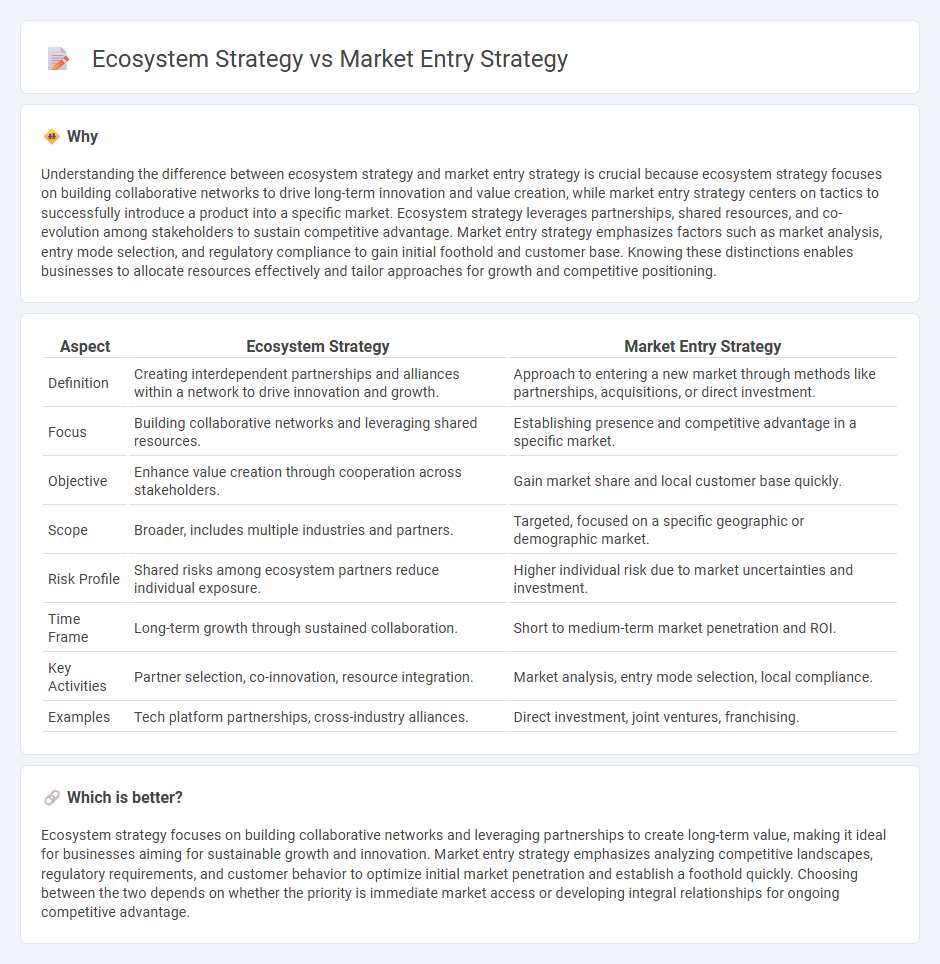
Ecosystem strategy focuses on creating value through interconnected partnerships and collaborative networks within an industry, enabling companies to leverage shared resources and innovation. Market entry strategy concentrates on identifying optimal approaches to enter new geographical or sector markets, emphasizing competitive analysis, customer segmentation, and regulatory considerations. Explore how blending these approaches can enhance strategic impact and business growth.
Why it is important
Understanding the difference between ecosystem strategy and market entry strategy is crucial because ecosystem strategy focuses on building collaborative networks to drive long-term innovation and value creation, while market entry strategy centers on tactics to successfully introduce a product into a specific market. Ecosystem strategy leverages partnerships, shared resources, and co-evolution among stakeholders to sustain competitive advantage. Market entry strategy emphasizes factors such as market analysis, entry mode selection, and regulatory compliance to gain initial foothold and customer base. Knowing these distinctions enables businesses to allocate resources effectively and tailor approaches for growth and competitive positioning.
Comparison Table
| Aspect | Ecosystem Strategy | Market Entry Strategy |
|---|---|---|
| Definition | Creating interdependent partnerships and alliances within a network to drive innovation and growth. | Approach to entering a new market through methods like partnerships, acquisitions, or direct investment. |
| Focus | Building collaborative networks and leveraging shared resources. | Establishing presence and competitive advantage in a specific market. |
| Objective | Enhance value creation through cooperation across stakeholders. | Gain market share and local customer base quickly. |
| Scope | Broader, includes multiple industries and partners. | Targeted, focused on a specific geographic or demographic market. |
| Risk Profile | Shared risks among ecosystem partners reduce individual exposure. | Higher individual risk due to market uncertainties and investment. |
| Time Frame | Long-term growth through sustained collaboration. | Short to medium-term market penetration and ROI. |
| Key Activities | Partner selection, co-innovation, resource integration. | Market analysis, entry mode selection, local compliance. |
| Examples | Tech platform partnerships, cross-industry alliances. | Direct investment, joint ventures, franchising. |
Which is better?
Ecosystem strategy focuses on building collaborative networks and leveraging partnerships to create long-term value, making it ideal for businesses aiming for sustainable growth and innovation. Market entry strategy emphasizes analyzing competitive landscapes, regulatory requirements, and customer behavior to optimize initial market penetration and establish a foothold quickly. Choosing between the two depends on whether the priority is immediate market access or developing integral relationships for ongoing competitive advantage.
Connection
Ecosystem strategy and market entry strategy are interconnected as a well-defined ecosystem facilitates a seamless market entry by leveraging established partnerships, resources, and customer networks. By aligning ecosystem capabilities with market demands, companies enhance competitive advantage and accelerate adoption in new markets. Effective integration of both strategies drives sustainable growth and innovation within targeted industry segments.
Key Terms
**Market Entry Strategy:**
Market entry strategy involves analyzing target markets to identify optimal entry modes such as exporting, joint ventures, franchising, or direct investment, with a focus on minimizing risks and maximizing profitability. It requires assessing competitive landscape, regulatory environment, customer preferences, and supply chain logistics to tailor the approach effectively. Discover more about how market entry strategy drives successful international expansion.
Market Analysis
Market entry strategy emphasizes thorough market analysis to identify target customer segments, assess competitor strengths and weaknesses, and evaluate market demand. Ecosystem strategy focuses on mapping relationships between key stakeholders, partners, and value chain participants to create a collaborative network that enhances market positioning. Explore the nuances of these strategies to optimize your business growth approach.
Mode of Entry
Market entry strategy defines the mode of entry such as exporting, franchising, joint ventures, or wholly-owned subsidiaries, emphasizing control, resource commitment, and risk levels. Ecosystem strategy, however, prioritizes collaborative partnerships, platform integration, and network effects to create value and drive competitive advantage within a connected industry environment. Discover how selecting the right mode of entry aligns with broader ecosystem participation to maximize market success.
Source and External Links
What is a Market Entry Strategy? - NMS Consulting - A market entry strategy involves detailed research to understand buyer behavior, competitor strengths, and local regulations, with common approaches including exporting, licensing, franchising, joint ventures, and direct investment to establish a business presence in a new market.
Market entry strategy - Wikipedia - A market entry strategy is a planned method for delivering goods or services to a new target market encompassing approaches such as direct setup, exporting, licensing, franchising, joint ventures, and considers factors like trade barriers and local competition.
5 steps to create a winning market entry strategy | BDC.ca - Developing a market entry strategy involves setting clear goals, researching the market, choosing a mode of entry, considering financing, and planning execution to achieve successful expansion into a foreign market.
 dowidth.com
dowidth.com